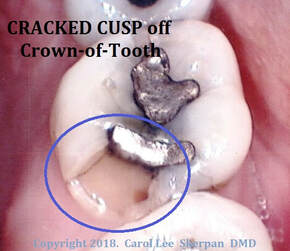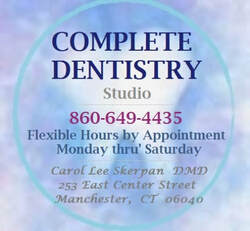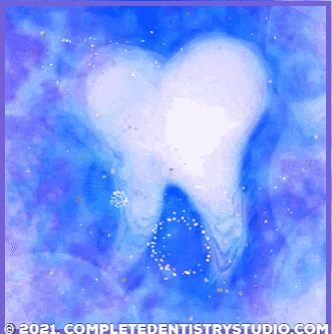' Oh, by the way!--this dental-blog is quite a 'LONG-tail'. I suggest not to 'bite off more than you can chew'. If you can't digest it all at once-- Just bite it off in smaller-chunks. Dare I say--it will be easier to 'ruminate' over it that way! '
MUSCLES: ' Maybe I should not assume that I fully understand the meaning of a 'bite' (aka occlusion). I know that I 'bite', chew, 'speak' & function only with an 'up-and- down' motion. How is my pup 'bite' different from how people 'bite'? ' DR SKERPAN: Good question!! You pups have sharp pointy teeth with no top- surfaces to work with, so there is no ability nor need for moving the teeth in 'all- around' motions. Pups only need Muscles and TMJoints to work 'up-and-down' with their sharp tooth-shapes. Human back-teeth have broad-top-surfaces (occlusal-surfaces). Therefore, people need Muscles and TMJoints which will work with their broad-surface Teeth positioned IN the lower-jaw & upper-skull. The human triad of Muscles, TMJoints and Teeth must be capable of operating all together 'in-sync'---AND must be capable of moving the teeth IN the lower- jaw 'up-and-down, front-and-back, side-to-side and all-around'. So FIRST, let's define the human occlusion. Occlusion is how the lower-teeth (in the lower-jaw) contact the upper-teeth (in the upper-skull). OR more simply put--the occlusion is where & how the teeth meet & touch, when the lower-teeth "relate" with the upper-teeth. But the human occlusion refers not only to the static-position of the lower & upper teeth meeting---BUT also to their dynamic- relationship as well!! This dynamic-relationship of the teeth is when they move against each other in any direction for any their functions. The human occlusion is BOTH static AND dynamic! And SECOND, the human Teeth do not stand nor function on their own without their own unique Muscles and TMJoints. Human Muscles, TMJoints & Teeth must function as a one Mouth-Jaw System fully dependent on & related to each other as one unit! Only all together can they accomplish the static AND the dynamic occlusion of 'biting', chewing, speaking, swallowing and moving 'up-and-down, front-and-back, side-to-side and all-around'. Humans DO NOT, DO NOT operate just 'up-and-down' in a 'one-bite-position'. AND "there's the catch" many people keep "missing"! The human occlusion is not a one-position 'bite' place! MUSCLES: ' I'm trying hard to catch & 'bite off' all these images in my doggy- mind. Let's see if I missed any points. NUMBER ONE---People-teeth do not operate in a one-position 'bite' place. People have lower and upper teeth which move 'in sync' dynamically with and against each other for all their functions. Human occlusion refers to both the static AND the dynamic occlusion! NUMBER TWO---People-jaws do not only work in an 'up-and-down' motion like our pup-jaws do. We have sharp pointy teeth and no broad-surfaces (occlusal-surfaces) to move our jaws 'all-around' on. Then it does seem to reason that you people do need a different Mouth-Jaw System to accommodate moving on your broad-surface teeth. The human Mouth-Jaw System requires a special complex triad of Muscles, TMJoints & Teeth working as an interdependent & interrelated unit to accomplish these feats. Hmm-mm! Just thinkin' about cows 'chewing cud' with their flat-top-teeth! Dare I say, they can 'ruminate' side-to-side! (I just crack myself up sometimes)! Anyway--after understanding these important facts about occlusion, can it be that the people triad- system implies something more for human dental-care? Does it mean considering more in treating and maintaining the teeth & occlusion for long term dental-health, dental-function and dental- longevity? '
Four muscles are important for moving the lower-jaw. The Masseter & Temporalis muscles connect the skull with the outer side of the lower-jaw. The Masseter muscles combined are one of the strongest muscles in the whole body. The Lateral Pterygoids & Medial Pterygoids connect the skull with the inner side of the lower-jaw (see pictures below). These 4 sets of muscles offer their own unique directions of function---but these 4 muscles (connecting the skull to the jaw) are responsible together for the lower-jaw's actions of chewing, grinding, opening, closing, pulling-forward, pulling-backward, side-to-side and all-around. Important to know here---these 4 sets of muscles do not act independently of all the other muscles of the skull, lower-jaw, neck, face & shoulders. If any jaw muscle is affected in it's function (or if forces to it are altered from any of the other surrounding muscles), the forces to ALL muscles are redistributed. If transmitted forces from the TMJoints or Teeth are changed, the Muscles of the Mouth-Jaw System are also affected with OR without pain or symptoms! Muscles stressed by too much force will become more bulky (hypertrophy), and those less used will waste and weaken (atrophy). The Mouth-Jaw System "accommodates" to muscle changes by reestablishing a new harmony & balance within the whole system--PERCEIVED BY THE PERSON OR NOT!! If pain does occur, it may manifest throughout the muscles as spasms, headaches, neck aches, a TMJ Disorder (see next section), lower-jaw pain or even as toothaches! WHY? Because when forces have been altered, symptoms may "refer" to any of the interdependent & interrelated structures! TMJoints (and their Lower-Jaw) The next complex 3-dimensional component of the human Mouth-Jaw System is the TMJoint. There are actually two TMJoints per lower-jaw---a right & left one. The right & left condyles (or 'balls') are the round ends of the lower-jaw (see pic- tures below). A TMJoint is the ball in the skull-socket, separated & cushioned by a cartilage-disk. A TMJoint is stabilized by muscles--it is one of the most complex joints in the body--and it is the most constantly used joint in the body. This joint works by hinging & gliding forward to open the lower-jaw.
If symptoms do occur from a TMJoint Disorder, they may manifest in the neck & face, pain in one or both TMJoints, pain in chewing, earaches, muscle stiffness and/or pain, TMJoint clicking or popping---or a change in how the teeth 'bite' together with OR without tooth pain or symptoms! WHY? Again--1 component affects the other 2 components of the Mouth-Jaw System, because they are all interrelated! Again--when forces have been altered, symptoms may "refer" to any of the interdependent & interrelated structures! MUSCLES: ' This is certainly "heady" stuff! (I just keep crackin' myself up!) And now we're going to add the teeth to this combo??!!! This is certainly a very long dental-blog! ' Dr Skerpan: Just hang in there--you can do it! We'll just begin to explore the teeth this time, so there will be some background knowledge for subsequent dental-blogs about occlusion. In those future blogs, we'll dive more into detail about teeth & their occlusion--and how all these relationships can go awry causing Occlusal Disease. But for now--- TEETH (and their surrounding perio-dontal structures) The Teeth are the third complex 3-dimensional component of the Mouth-Jaw System. When a tooth or multiple teeth are changed in structure or number or function, the forces throughout the Mouth-Jaw System are changed. Remember, the teeth transmit heavy forces into the lower-jaw, upper-skull, the TMJoints and Muscles. These redistributed forces also transmit different new forces to the other teeth within the lower & upper arches, which may cause damage to the teeth sooner or later. Sometimes it is impossible to distinguish whether a tooth has been damaged by redistributed forces within the triad-system, local tooth trauma, decay, other oral conditions, oral habits or just normal use. Nonetheless---tooth problems, symp- toms, pain and/or infections may arise in teeth which have been over-stressed overtime from altered forces--from any time or by any factor.
The characteristics of the teeth define the occlusion--and the occlusal-surfaces (top-surfaces) are the means through which the forces are transmitted to the Muscles and TMJoints. When occlusal-forces are changed because of a misa- ligned bite for any reason, detrimental changes occur within components of the of the Mouth-Jaw System. When detrimental changes occur within the Teeth component of the System, it is called Occlusal Disease. Remember, if forces are altered because of only one tooth, the new forces must be redistributed to all the other teeth. And hence, the occlusion is inevitably altered with the changed occlusal-forces transmitting differently to the other Teeth AND the other 2 components of Muscles and TMJoints. Because all structures are interdependent & interrelated, a reestablished har- mony & balance inevitably occurs---PERCEIVED BY THE PERSON OR NOT!! If pain does occur, it may manifest at the original tooth source--OR at any other teeth to which the new forces have shifted. Again--if pain or symptoms do occur, they may manifest within any of the 3 components of Teeth, Muscles or TMJoints. WHY? Because when forces have been altered, symptoms may "refer" to any of the interdependent & interrelated structures! ----------------------------------------------------------
' A problem within 1 component may affect any aspect within itself---and/or may affect any aspect of the other 2 components. In other words, a change in 1 com- ponent affects change within itself AND in the other 2 components! As I see it--- it's a miracle that pain or symptoms don't radiate and "refer" all-over the teeth, lower-jaw, upper-skull, neck, face and shoulders more often than it does!!! ' Dr Skerpan: And that is why there should not be a 'one-tooth-only' mentality in dental-care ---not if the goal is true overall dental-health AND dental-treatment longevity!! Even if one tooth is treated, it should be carefully restored & considered within the larger system it's a part of. Because of the complexities which now can be appreciated, it should be clear that careful attention to dental-care is imperative. Dental treatment and maintenance should respect the harmony and balance of the person's Mouth-Jaw System if it is healthy and symptom-free. Dental-care's goal should be to preserve the conditions, teeth and occlusal-forces provided that the oral environment is stable & symptom-free. OR the goal should be to restore, adjust and/or reestablish the conditions, teeth and/or occlusal- forces if necessary for an improved healthy harmonious & balanced Mouth-Jaw System. The aim of dental-care should be for long-term overall dental-health, dental-function & dental-longevity as part of the overall body-health! ----------------------------------------------------------- MUSCLES: ' Well, I'm 'pooped'! I can't 'bite off' any more chunks of info'-- I can't 'ruminate' or digest a single thing more! All this complexity has bamboozled my doggy-brain TOO much. It's QUITTIN' TIME!! ' ----------------------------------------------------------------------------------
1 Comment
|
Author
|






































 RSS Feed
RSS Feed